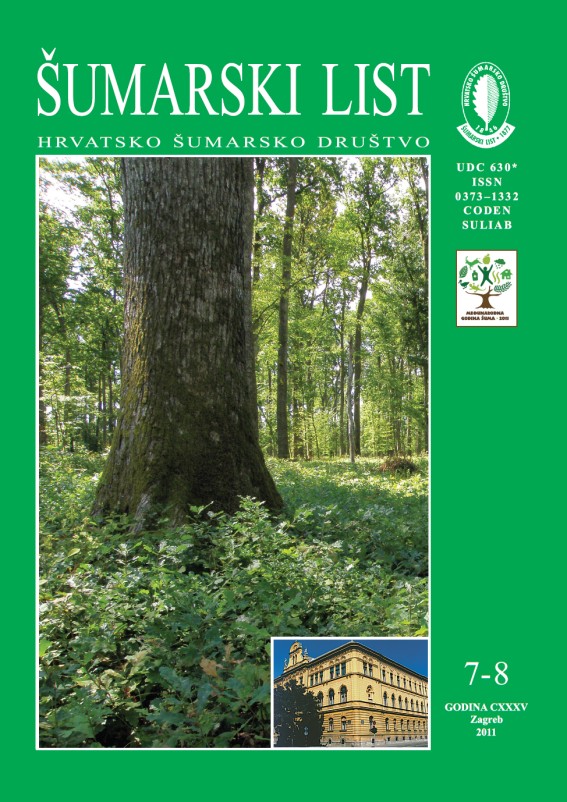| |
| RIJEČ UREDNIŠTVA |
| |
|
|
| EDUCATION AND EMPLOYMENT
pdf
HR
EN
|
341 |
| |
| IZVORNI ZNANSTVENI ČLANCI |
| |
|
|
| Jakovljević,T., M. Gradečki-Poštenjak, I. Radojčić Redovniković | UDK 630* 232.3 (Pinus pinea L.) (001) |
| Physiological, Chemical andAntioxidant Properties of Fresh and Stored Stone Pine Seed (Pinus pinea L.)
pdf
HR
EN
|
343 |
| |
| PRETHODNO PRIOPĆENJE |
| |
|
|
| Mihoci, I., M. Franjević | UDK 630* 453 |
| Rare and Threatened Geometrid Moth Erannis ankeraria in Croatia: Historical Review, data Analysis & Perspectives
pdf
HR
EN
|
353 |
| Kajba,D., J. Domac, V. Šegon | UDK 630* 537 + 238 |
| Procjena potencijala brzorastućih nasada u Republici Hrvatskoj: Primjer razultata u sklopu FP7 projekta Biomass energy Europe
pdf
HR
EN
|
361 |
| Kličić,H., S. Govorčin,T. Sinković, S. Gurda,T. Sedlar | UDK 630* 812 (Pinus sylvestris L.) |
| Macroscopic Characteristics and Density of Scots Pine (Pinus Sylvestris L.) from Cazin, Bosnia and Herzegowina
pdf
HR
EN
|
371 |
| |
| STRUČNI ČLANCI |
| |
|
|
| Barčić, D., N. Panić | UDK 630* 907 |
| Ecological Valorisation of the ProtectedArea of “Kopački Rit” Nature Park
pdf
HR
EN
|
379 |
Summary: With its specific features, high diversity, and a multitude of exceptional ecological systems, the nature park of Kopački Rit is one of the most important areas in the east of Croatia. According to the National Habitat Classification and Map of the Republic of Croatia, there are 25 habitat types in the area of the nature park. Five of these are endangered at the European level and protected by the Habitats Directive. Kopački Rit Nature Park has been included on the Ramsar list as valuable natural heritage within the international framework. The floodplain area of Kopački Rit is essential due to the coherence and diversity of terrestrial and aquatic ecological systems. The paper addresses the need for ecological and spatial valorisation of the protected area as an instrument for discriminating between primary and secondary protection. Kopački Rit is a floodplain area resulting from the activity of two large rivers: the Danube and the Drava. Spatial analysis of Kopački Rit Nature Park was made on the basis of the existing spatial plan (2006) of the area. Comparative methods, as well as the analysis and synthesis method were used for the process. A qualitative analytical method with element gradation within four analysis fields was used – strengths, weaknesses, opportunities and threats (SWOT analysis). A structural area analysis (Figure 1) was made according to Lynch (1972). The effect of the activities on biological and landscape diversity was analyzed in the results. The analysis included the effects of forestry, water management, agriculture, game management, traffic, and war events (Table 1 and 2). Based on the management plan, zonation was performed by defining the main zones and determining the sub-zones (Figure 2). The zones were described and the zonation criteria and management goals were provided. In doing so, the difference between the zones of strict protection and active protection was accentuated. The goal of management is to ensure a sustainable use of floodplain valleys and allow visits, recreational fishing, hunting, forestry and agriculture. In order to improve habitat quality, use of the area should be limited by management measures. Ecological and spatial analyses of the protected nature park area were used to determine the difference between individual units within Kopački Rit. Special zones of the basic phenomenon were highlighted, which coincides with the zoning concept within the nature park. In this sense, primary and secondary protection was discriminated.
Key words: diversity; habitat; nature protection; sustainable development; zoning |
| Mayer, Željko | UDK 630* 232 (Juglans nigra L.) |
| Establishing Cultures of Black Walnut (Juglans nigra L.) by Generative Propagation
pdf
HR
EN
|
391 |



